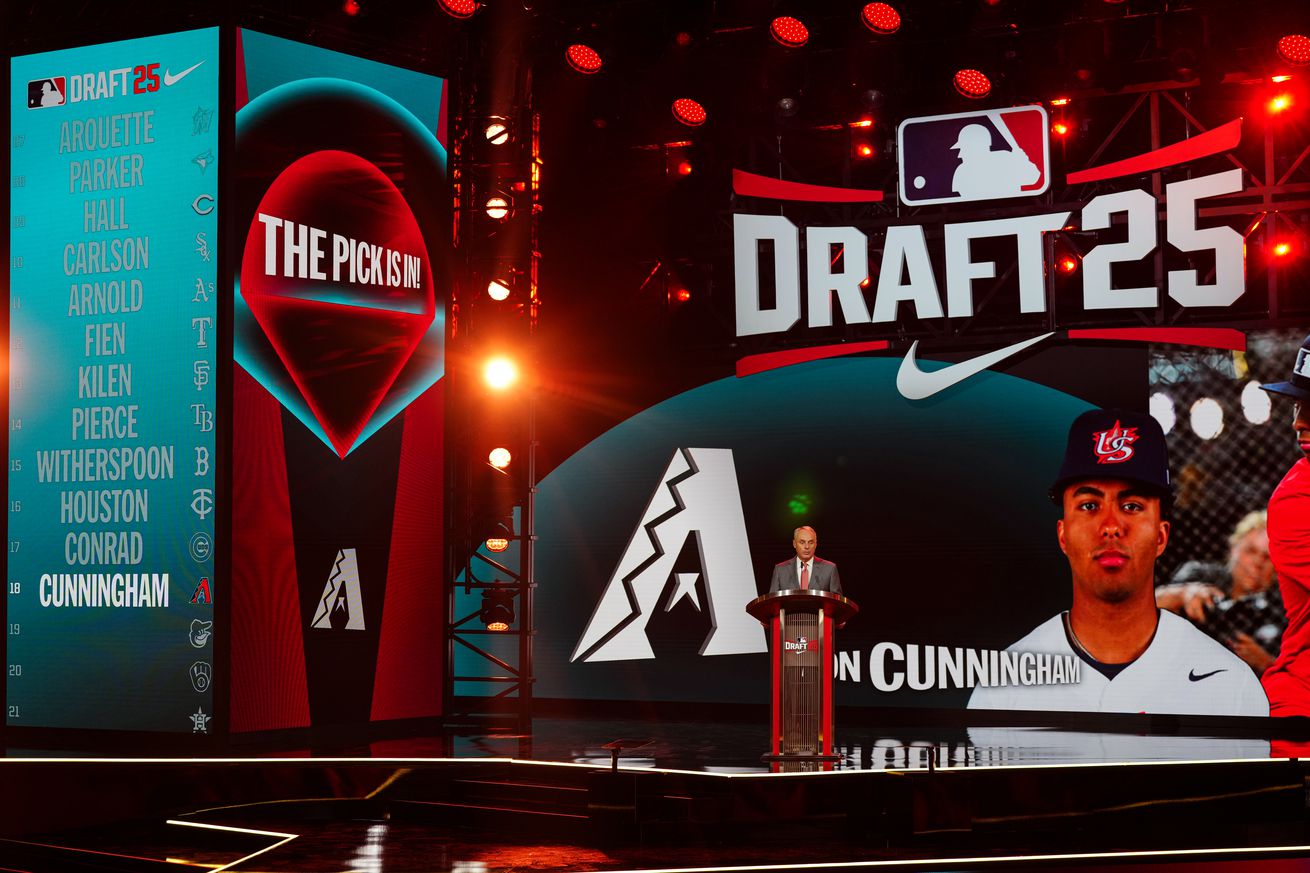
A busy day, with no fewer than seventeen picks.
After the slow cooking of the first three rounds, today will be the draft equivalent of fast food. Over five hundred players will be selected today, by the time the last player in the 20th round knows their fate. Last year, the draft was split over three days, but MLB has compressed everything outside the top hundred-odd picks into the second day. Expect a lot of rapid movement. I don’t think we’ll be doing individual articles on picks, but do refresh this page for updates and comments on any Diamondbacks selections of note.
Coverage of the draft today will all be online, available through MLB.com. There are still some highly-rated players to be had, with more than a quarter of MLB Pipeline’s top 100 prospects still available to be selected. The highest is Oregon outfielder Mason Neville, at #35, but who would object to the Diamondbacks picking 44th-ranked high-school leftie Jack Bauer, who has a 103 mph fastball and, yes, wears #24.
According to MLB, “There will be one minute between picks for Rounds 4-10 and a 10-minute break between Rounds 6 and 7. There will also be a one-hour break between Rounds 10 and 11 and then no delay between selections after that (beyond another 10-minute pause after Round 15).” The Diamondbacks will have the eighteenth selection in each round.
If you followed the third round of the draft on MLB Network (or MLB.com) last night, today will move at that pace or faster. It will probably be that same pace through the tenth round, and then there will be basically a pick every minute. It’s fast. While it doesn’t make a lot of sense in my mind to have drafts as a television event, at least there’s a lot of action in the baseball draft, unlike some drafts I could name.
With the draft being compressed to twenty rounds from forty, it’s not as likely that there will be names taken that are complete unknowns, but it can still happen. (We saw the Dodgers take a player last night that MLB Network did not have a headshot for, which generally happens at least a couple times in the first few rounds and becomes pretty normal as time goes on.) Anyway, James and I will likely not be done researching one pick before the next one is made. There’s not much downtime. After all, there will be 510 picks made today.
But even with 105 picks made yesterday, there are still plenty of known players available, led by two outfielders that play college ball in the state of Oregon. Gavin Turley has been connected with the Diamondbacks (and they drafted him out of high school) and certainly would fit, but Mason Neville is the other top name, and would be even more likely if he lasts to the Diamondbacks, as he’s expected to be able to stick in center field and is a left-handed bat. There are also a few high school names that teams who saved some money in the early rounds might target, such as Jayden Stroman (younger brother of Marcus).
As far as the Diamondbacks are concerned, there are some local names that would have interest if the signability is there. Top among these is Brett Crossland, a big right-handed pitcher out of Corona Del Sol High School who is likely to head to Texas, but has a lot of interests from scouts. His teammate Zane Burns doesn’t have anywhere near the same level of interest, but also might be more signable. He’s an Oklahoma State commit.
One thing I like to track is players from unusual places (both in terms of birthplaces and schools attended.) There has never been a major league player born in Ghana. Josh Schleichardt, a third baseman from Vanguard University, will be looking to change that. He’s a long shot to get drafted, let alone ever make the major leagues, but he’s been tearing up the West Coast League, showcasing both power and speed. His 15 home runs lead the league, he’s batting .336, and has stolen seven bases. He’s also playing the outfield there. Micah Bucknam, a Canadian born in New Zealand, is more likely to be the first big leaguer from his birthplace. After not pitching much at LSU, he started at pitching factory Dallas Baptist and got good results, particularly when it comes to strikeout numbers. There’s Mason Estrada, the right handed pitcher from MIT who is certain to be drafted, but there’s also Tyler Johnson, another right handed pitcher with similar strikeout numbers from Alma College in Michigan. Of more interest for the Diamondbacks would be Ethan Tuttle, a left-handed batting shortstop who hit .409 for his career at Spalding, a tiny school in Kentucky that has never had a major league player. Keep in mind that the Diamondbacks have drafted players from Bellarmine and Transylvania in recent years, so they certainly scout this area, and Tuttle might be this year’s Trent Youngblood.
Anyway, there’s plenty to keep track of. Too much, in fact, but we’ll have at least some coverage of every Diamondbacks’ pick here.
